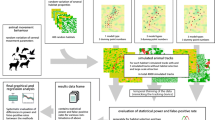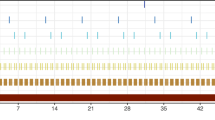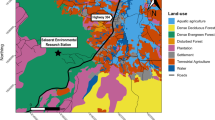Abstract
Context
GPS telemetry collars and their ability to acquire accurate and consistently frequent locations have increased the use of step selection functions (SSFs) and path selection functions (PathSFs) for studying animal movement and estimating resistance. However, previously published SSFs and PathSFs often do not accommodate multiple scales or multi-scale modeling.
Objectives
We present a method that allows multiple scales to be analyzed with SSF and PathSF models. We also explore the sensitivity of model results and resistance surfaces to whether SSFs or PathSFs are used, scale, prediction framework, and GPS collar sampling interval.
Methods
We use 5-min GPS collar data from pumas (Puma concolor) in southern California to model SSFs and PathSFs at multiple scales, to predict resistance using two prediction frameworks (paired and unpaired), and to explore potential bias from GPS collar sampling intervals.
Results
Regression coefficients were extremely sensitive to scale and pumas exhibited multiple scales of selection during movement. We found PathSFs produced stronger regression coefficients, larger resistance values, and superior model performance than SSFs. We observed more heterogeneous surfaces when resistance was predicted in a paired framework compared with an unpaired framework. Lastly, we observed bias in habitat use and resistance results when using a GPS collar sampling interval longer than 5 min.
Conclusions
The methods presented provide a novel way to model multi-scale habitat selection and resistance from movement data. Due to the sensitivity of resistance surfaces to method, scale, and GPS schedule, care should be used when modeling corridors for conservation purposes using these methods.







Similar content being viewed by others
References
Agresti A (2002) Categorical data analysis, 2nd edn. Wiley, Hoboken, p 419
Beier P, Majka D, Spencer WD (2008) Forks in the road: choices in procedures for designing wildlife linkages. Conserv Biol 22:836–851
Brown DD, LaPoint S, Kays R, Heidrich W, Kummeth F, Wikelski M (2012) Accelerometer-informed GPS telemetry: reducing the trade-off between resolution and longevity. Wildl Soc Bull 36:139–146
Burdett CL, Crooks KR, Theobald DM, Wilson KR, Boydston EE, Lyren LM, Fisher RN, Vickers TW, Morrison SA, Boyce WM (2010) Interfacing models of wildlife habitat and human development to predict the future distribution of puma habitat. Ecosphere 1:1–21
Burnham KP, Anderson DR (2002) Model selection and multimodel inference: a practical information-theoretic approach, 2nd edn. Springer, New York. ISBN 978-0-387-22456-5
California Department of Fish and Game (1988) A guide to wildlife habitats of California. In: Mayer KE, Laudenslayer Jr WF (eds) State of California Resources Agency. Department of Fish and Game, Sacramento, p 166. http://www.dfg.ca.gov/biogeodata/cwhr/wildlife_habitats.asp#Tree. Accessed 29 Jan 2013
Compton BW, Rhymer JM, McCollough M (2002) Habitat selection by wood turtles (Clemmys insculpta): an application of paired logistic regression. Ecology 83:833–843
Coulon A, Morellet N, Goulard A, Cargnelutti B, Angibault JM, Hewison AJM (2008) Inferring the effects of landscape structure on roe deer (Capreolus capreolus) movements using a step selection function. Landscape Ecol 23:603–614
Crooks KR, Sanjayan M (2006) Connectivity conservation: maintaining connections for nature. In: Crooks KR, Sanjayan M (eds) Connectivity conservation. Cambridge University Press, Cambridge, p 1
Cushman SA, Lewis JS (2010) Movement behavior explains genetic differentiation in American black bears. Landscape Ecol 25:1613–1625
Cushman SA, Chase M, Griffin C (2010) Mapping landscape resistance to identify corridors and barriers for elephant movement in South Africa. In: Cushman SA, Huettmann (eds) Spatial complexity, informatics, and wildlife conservation. Springer, Japan, pp 349–367. ISBN 978-4-431-87770-7
Cushman SA, McRae B, Adriaensen F, Beier P, Shirley M, Zeller K (2013) Biological corridors and connectivity. In: Macdonald DW, Willis KJ (eds) Key topics in conservation biology 2. Wiley-Blackwell, Hoboken, pp 384–404
Cushman SA, Lewis JS, Landguth EL (2014) Why did the bear cross the road? Comparing the performance of multiple resistance surfaces and connectivity modeling methods. Diversity 6:844–854
DeCesare NJ, Hebblewhite M, Schmiegelow F, Hervieux D, McDermid GJ, Neufeld L, Bradley M, Whittington J, Smith KG, Morgantini LE, Wheatley M, Musiani M (2012) Transcending scale dependence in identifying habitat with resource selection functions. Ecol Appl 22:1068–1083
Dickson BG, Beier P (2007) Quantifying the influence of topographic position on cougar (Puma concolor) movement in southern California, USA. J Zool 271:270–277
Dickson BG, Jenness JS, Beier P (2005) Influence of vegetation, topography, and roads on cougar movement in southern California. J Wildl Manag 69:264–276
Elliot NB, Cushman SA, Macdonald DW, Loveridge AJ (2014) The devil is in the dispersers: predictions of landscape connectivity change with demography. J Appl Ecol. doi:10.1111/1365-2664.12282
Ernest HB, Vickers TW, Morrison SA, Buchalski MR, Boyce WM (2014) Fractured genetic connectivity threatens a southern California puma (Puma concolor) population. PLoS ONE 9(10):e107985. doi:10.1371/journal.pone.0107985
Estrada EG, Alva JAV (2011) Package gPdtest: bootstrap goodness-of-fit test for the generalized Pareto distribution. http://cran.r-project.org/web/packages/gPdtest/index.html. Accessed 11 Feb 2015
Fortin D, Beyer HL, Boyce MS, Smith DW, Duchesne T, Mao JS (2005) Wolves influence elk movements: behavior shapes a trophic cascade in Yellowstone National Park. Ecology 86:1320–1330
Holland JD, Bert DG, Fahrig L (2004) Determining the spatial scale of species’ response to habitat. Bioscience 54:227–233
Johnson D (1980) The comparison of usage and availability measurements for evaluating resource preference. Ecology 61:65–71
Johnson CJ, Nielsen SE, Merrill EH, Mcdonald TL, Boyce MS (2006) Resource selection functions based on use-availability data: theoretic motivation and evaluation methods. J Wildl Manag 70:347–357
Joly K (2005) The effects of sampling regime on the analysis of movements of overwintering female caribou in east-central Alaska. Rangifer 25:67–74
Kertson BN, Spencer RD, Marzluff JM, Hepinstall-Cymerman J, Grue CE (2011) Cougar space use and movements in the wildland-urban landscape of western Washington. Ecol Appl 21:2866–2881
Lewis JS, Rachlow JL, Garton EO, Vierling LA (2007) Effects of habitat on GPS collar performance: using data screening to reduce location error. J Appl Ecol 44:663–671
Lin LI (1989) A concordance correlation coefficient to evaluate reproducibility. Biometrics 1:255–268
Manly BF, Mcdonald L, Thomas DL, Mcdonald TL, Erickson WP (2002) Resource selection by animals: statistical design and analysis for field studies, 2nd edn. Kluwer Academic Publishers, Dordrecht
Martin AE, Fahrig L (2012) Measuring and selecting scales of effect for landscape predictors in species–habitat models. Ecol Appl 22:2277–2292
McGarigal K, Wan H, Zeller KA, Timm BC, Cushman SA (accepted) Multi-scale habitat modeling: A review and outlook. Landscape Ecol
McRae BH, Dickson BG, Keitt TH, Shah VB (2008) Using circuit theory to model connectivity in ecology, evolution, and conservation. Ecology 89:2712–2724
McRae BH, Shah VB, Mohapatra TK (2013) Circuitscape 4 user guide. The Nature Conservancy. http://www.circuitscape.org. Accessed 19 May 2015
Mills KJ, Patterson BR, Murray DL (2006) Effects of variable sampling frequencies on GPS transmitter efficiency and estimated wolf home range size and movement distance. Wildl Soc Bull 34:1463–1469
Norththrup JM, Hooten MB, Anderson CR Jr, Wittemyer G (2013) Practical guidance on characterizing availability in resource selection functions under a use-availability design. Ecology 94:1456–1463
Potts JR, Mokross K, Stouffer PC, Lewis MA (2014) Step selection techniques uncover the environmental predictors of space use patterns in flocks of Amazonian birds. Ecol Evol 24:4578–4588
R Core Team (2013) R: a language and environment for statistical computing. R Foundation for Statistical Computing, Vienna. http://www.R-project.org/. Accessed 15 May 2013
Reding DM, Cushman SA, Gosselink TE, Clark WR (2013) Linking movement behavior and fine-scale genetic structure to model landscape connectivity for bobcats (Lynx rufus). Landscape Ecol 28:471–486
Rettie WJ, McLoughlin PD (1999) Overcoming radio telemetry bias is habitat-selection studies. Can J Zool 77:1175–1184
Richard Y, Armstrong DP (2010) Cost distance modeling of landscape connectivity and gap-crossing ability using radio-tracking data. J Appl Ecol 47:603–610
Roever CL, Boyce MS, Stenhouse GB (2010) Grizzly bear movements relative to roads: application of step selection functions. Ecography 33:1113–1122
Squires JR, DeCesare NJ, Olson LE, Kolbe JA, Hebblewhite M, Parks SA (2013) Combining resource selection and movement behavior to predict corridors for Canada lynx at their southern range periphery. Biol Conserv 157:187–195
Thurfjell H, Ciuti S, Boyce MS (2014) Applications of step-selection functions in ecology and conservation. Mov Ecol 2:4
USDA Forest Service (2007) CalVeg: FSSDE.Eveg-Tile47A_02_v2. Pacific Southwest Region Remote Sensing Lab, McClellan
Van Beest FM, Van Moorter B, Milner JM (2012) Temperature-mediated habitat use and selection by a heat-sensitive northern ungulate. Anim Behav 84:723–735
Vickers TW, Sanchez JN, Johnson CK, Morrison SA, Botta R, Smith T, Cohen BS, Huber PR, Ernest HB, Boyce WM (2015) Survival and mortality of pumas (Puma concolor) in a fragmented, urbanizing landscape. PlosONE. doi:10.1371/journal.pone.0131490
Wheatley M, Johnson C (2009) Factors limiting our understanding of ecological scale. Ecol Complex 6:150–159
Wilmers CC, Wang Y, Nickel B, Houghtaling P, Shakeri Y, Allen ML, Kermish-Wells J, Yovovich V, Williams T (2013) Scale dependent behavioral responses to human development by a large predator, the puma. PLoS ONE. doi:10.1371/journal.pone.0060590
Zeller KA, McGarigal K, Whiteley AR (2012) Estimating landscape resistance to movement: a review. Landscape Ecol 27:777–797
Zeller KA, McGarigal K, Beier P, Cushman SA, Vickers TW, Boyce WM (2014) Sensitivity of landscape resistance estimates based on point selection functions to scale and behavioral state: pumas as a case study. Landscape Ecol 29:541–557
Acknowledgments
We thank B. Compton and E. Plunkett, for assistance with computational capacity, D. Dawn, D. Krucki, C. Bell, P. Bryant, D. Stewart, and K. Krause for field assistance. We would also like to thank the following landowners/managers: The Nature Conservancy, California Department of Fish and Wildlife, Orange County Parks Department, The New Irvine Ranch Conservancy, Audubon Starr Ranch Reserve, Riverside County Parks Department, and the Cleveland National Forest. This material is based upon work supported by the National Science Foundation under NSF DGE-0907995, a Kaplan Graduate Award, The Nature Conservancy, Orange County Transportation Corridor Agency, The Nature Reserve of Orange County, and the McBeth Foundation.
Author information
Authors and Affiliations
Corresponding author
Additional information
Special issue: Multi-scale habitat modeling.
Guest Editors: K. McGargial and S.A. Cushman.
Electronic supplementary material
Below is the link to the electronic supplementary material.
Rights and permissions
About this article
Cite this article
Zeller, K.A., McGarigal, K., Cushman, S.A. et al. Using step and path selection functions for estimating resistance to movement: pumas as a case study. Landscape Ecol 31, 1319–1335 (2016). https://doi.org/10.1007/s10980-015-0301-6
Received:
Accepted:
Published:
Issue Date:
DOI: https://doi.org/10.1007/s10980-015-0301-6




